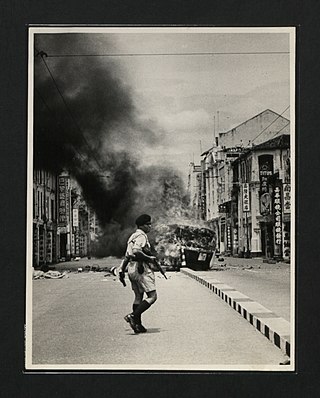
Benjamin Henry Sheares was a Singaporean physician and academic who served as the second president of Singapore from 1971 until his death in 1981. Of Eurasian descent, Sheares was born in Singapore under British rule and graduated from the King Edward VII College of Medicine. He studied obstetrics and gynaecology and worked as an obstetrician at the Kandang Kerbau Hospital (KKH), eventually serving as the Acting Professor of Obstetrics and Gynaecology at the University of Malaya in Singapore. He later became the Professor of Obstetrics and Gynaecology at the university, a rare feat for a local as usually high-ranking colonial officers held such positions.

The Chinese middle school student riots were a series of riots in Singapore that broke out between the Chinese community in 1956, resulting in 13 people killed and more than 120 injured.

Dover MRT station is an elevated Mass Rapid Transit (MRT) station on the East West line (EWL) in Singapore. Located along Commonwealth Avenue West, the station is directly linked to Singapore Polytechnic and serves various residential developments in the area. The station is operated by SMRT Trains.

Bukit View Secondary School (BTVSS) is a co-educational government secondary school in Bukit Batok, Singapore.

Toa Payoh MRT station is an underground Mass Rapid Transit (MRT) station on the North South line (NSL) in Toa Payoh, Singapore. Located in the town centre of Toa Payoh, it is integrated with the Toa Payoh Bus Interchange and the HDB Hub, headquarters of the Housing and Development Board. The station is underneath the intersection of three roads: Lorong 1 Toa Payoh, Lorong 2 Toa Payoh and Lorong 6 Toa Payoh.
The following lists events that happened during 1997 in Singapore.
Yusof bin Ishak was a Singaporean journalist and senior civil servant who served as the first president of Singapore between 1965 and 1970. His portrait appears on the Singapore Portrait Series currency notes introduced in 1999.

Chinese Garden MRT station is an elevated Mass Rapid Transit (MRT) station on the East–West line (EWL) in Jurong East, Singapore. Operated by SMRT Trains, the station serves the eponymous Chinese Garden and the Yuhua residential estate. Other nearby landmarks include Jurong Primary School and Fuhua Secondary School.

The 1964 race riots in Singapore involved a series of communal race-based civil disturbances and racially-motivated violence between the Malays and Chinese in Singapore following its merger with Malaysia in 16 September 1963, and were considered to be the "worst and most prolonged in Singapore's postwar history". The term is also used to refer specifically to two riots on 21 July 1964 and 2 September 1964, particularly the former, during which 23 people died and 454 others suffered severe injuries.

The People's Association (PA) is a statutory board under the Ministry of Culture, Community and Youth (MCCY) of the Government of Singapore that oversees neighbourhood communities and social organisations. Established in 1960, it was part of a nation-building programme to promote social cohesion and multiracialism.

Maris Stella High School (MSHS) (Chinese: 海星中学; pinyin: Hǎixīng Zhōngxué) is a government-aided, all-boys Catholic secondary school with autonomous status. As a full school, it comprises a primary section offering a six-year programme leading up to the Primary School Leaving Examination, as well as a secondary section offering a four-year programme leading up to the Singapore-Cambridge GCE Ordinary Level examinations. Run by the international Marist Brothers at Mount Vernon Road, Singapore near Bartley MRT station, Maris Stella High School is one of the eleven Special Assistance Plan(SAP) high schools in Singapore.

Since Singapore's independence in 1965, the human rights of Singaporeans have been set out in the Constitution of Singapore and include rights found in subsequent amendments and referendums. These rights have evolved through Singapore's history as a part of the Straits Settlements, its years under Japanese occupation, its position as a separate self-governing crown colony, and its present day status as a sovereign island country and city-state.

Singapore, officially the State of Singapore, was one of the 14 states of Malaysia from 1963 to 1965. Malaysia was formed on 16 September 1963 by the merger of the Federation of Malaya with the former British colonies of North Borneo, Sarawak and Singapore. This marked the end of the 144-year British rule in Singapore which began with the founding of modern Singapore by Sir Stamford Raffles in 1819. At the time of merger, it was the smallest state in the country by land area, but the largest by population.
Xinyao is a genre of songs originating from Singapore. It is a contemporary Mandarin vocal genre that emerged between the late 1970s to 1980s. Xinyao songs are typically composed and sung by Singaporeans, although there are exceptions: one of the most notable being Eric Moo, who is not Singaporean but Malaysian, yet is considered one of the pioneers of the movement.

The Singapore Conference Hall, formerly the Singapore Conference Hall and Trade Union House, is a multipurpose building in Shenton Way, Singapore. Designed in modernist style, the SCH is five stories tall and capped with a cantilevered V-shaped roof. The SCH houses the Singapore Chinese Orchestra (SCO); the concert hall has a capacity of 831 people. It was the first post-colonial building to be gazetted as a national monument in Singapore.
The Racial and Religious Harmony Circles, formerly known as Inter-Racial and Religious Confidence Circles (IRCCs), are local-level inter-faith platforms in every constituency, formed to promote racial and religious harmony. The work of the Harmony Circle is instrumental in strengthening social cohesion and supports the SGSecure movement.
The concept of race or ethnicity in contemporary Singapore emerged from the attitudes of the colonial authorities towards race and ethnicity. Before the early 2000s, the four major races in Singapore were the Chinese, Malays, Indians and Eurasians. Today, the Chinese-Malay-Indian-Others (CMIO) model is the dominant organising framework of race in Singapore. Race informs government policies on a variety of issues such as political participation, public housing and education. However, the state's management of race, as well as the relevance of the CMIO model, has been a point of contention amongst some in recent years.

Yong Nyuk Lin was a Singaporean former politician who served as the Minister for Communications between 1968 and 1975, Minister for Health between 1963 and 1968, and Minister for Education between 1959 and 1963.

Singaporeans are the citizens and nationals of the sovereign island city-state of Singapore. Singapore is home to a people of a variety of ethno-racial-religious origins, with the city-state itself being a multi-racial, multi-cultural, multi-religious, multi-denominational, multi-lingual, and multi-ethnic country. Singaporeans of Chinese, Malay, Indian and Eurasian descent have made up the overwhelming majority of the population since the 19th century. The Singaporean diaspora is also far-reaching worldwide.

Alvin Tan Sheng Hui is a Singaporean politician who has been serving as Minister of State for Trade and Industry and Minister of State for Culture, Community and Youth concurrently since 2020. A member of the governing People's Action Party (PAP), he has been the Member of Parliament (MP) representing the Moulmein–Cairnhill division of Tanjong Pagar GRC since 2020.














